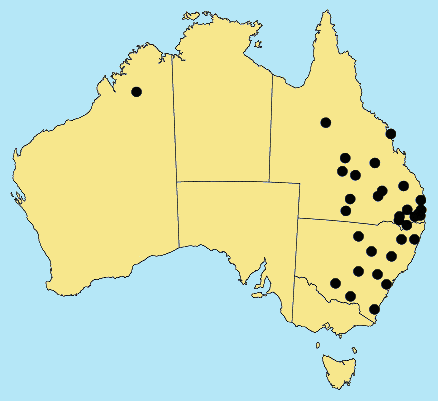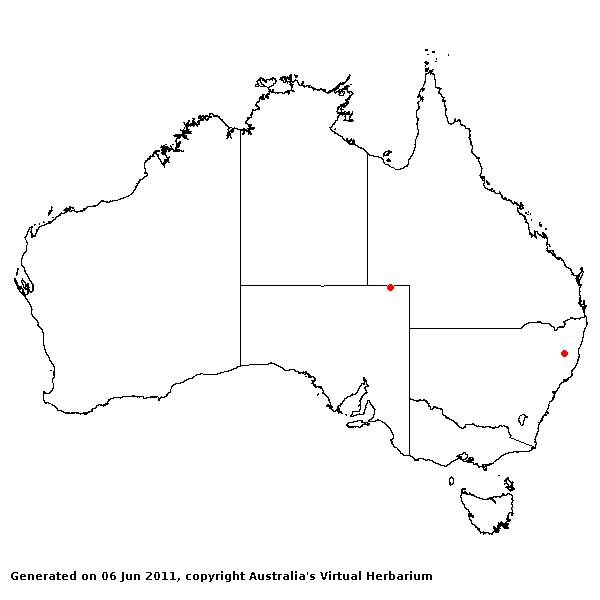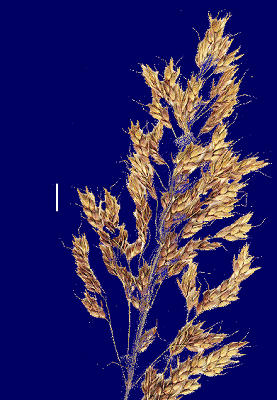Sorghum
drummondii* (Steud.) Millsp.
& Chase. Publ. Field Columb. Mus.Bot. 3: 21 (1903).
Classification. (GPWG 2001) : Subfamily Panicoideae. Andropogoneae.
Basionym and/or
Replacement Name: Andropogon
drummondii Nees ex Steud., Syn. Pl. Glumac. 1: 393 (1854).
Type of Basionym or
Protologue Information: HT: Drummond 588, USA: Louisisana: near New
Orleans and St. Louis (P?; IT: BM, K).
Recent synonyms:
S. bicolor subsp. drummondii, S. sudanense.
Key references
(books and floras): [1952] C.A.Gardner, Flora of Western Australia 1
Gramineae (317 as S. sudanense), [2002] D.Sharp & B.K.Simon, AusGrass,
Grasses of Australia, [2008] S.W.L.Jacobs, R.D.B.Walley &
D.J.B.Wheeler, Grasses of New South Wales (as S. bicolor subsp. drummondii).
Illustrations:
[2008] S.W.L.Jacobs, R.D.B.Whalley & D.J.B.Wheeler, Grasses of New South
Wales, 4th edn (372).
Habit. Annual.
Rhizomes absent. Culms erect, 150–300 cm tall, 3–6 mm diam., 6–9 -noded.
Mid-culm nodes pubescent. Lateral branches simple. Leaves cauline. Ligule a
fringed membrane, a ciliolate membrane, 2 mm long. Leaf-blades 15–50 cm long,
8–12 mm wide.
Inflorescence.
Inflorescence compound, a panicle of rames. Panicle ovate or pyramidal, 15–30
cm long, 8–15 cm wide. Rhachis tough.
Spikelets.
Spikelets sessile, 1 in the cluster. Companion spikelets pedicelled, 1 in the
cluster. Companion spikelets developed, male, 5.5–8 mm long. Companion spikelet
glumes muticous. Fertile spikelets 2-flowered, the lower floret barren (rarely
male), the upper fertile, comprising 1 basal sterile florets, comprising 1
fertile floret(s), without rachilla extension, lanceolate or elliptic or
oblong, dorsally compressed, 6–7.5 mm long.
Glumes.
Glumes dissimilar, firmer than fertile lemma, shiny. Lower glume elliptic,
coriaceous, much thinner above, without keels, 11–15 -nerved. Lower glume
surface glabrous or indumented. Upper glume elliptic, coriaceous, without
keels, 7 -nerved. Upper glume surface indumented. Florets. Basal sterile
florets 1, barren, without significant palea. Lemma of lower sterile floret
hyaline, 2 -nerved.
Fertile lemma 3.5–4.5 mm
long, 1 -nerved. Lemma apex dentate, awned, 1 -awned. Median (principal) awn
from a sinus, 10–16 mm long overall, with a twisted column. Palea absent.
Lodicules present. Anthers 3. Grain 3.5–4.5 mm long.
Continental
Distribution: Europe, Africa, Temperate Asia, Tropical Asia, Australasia,
Pacific, North America, and South America.
Australian
Distribution: Western Australia, Queensland, New South Wales.
Western Australia:
Dampier. Queensland: Burke, Burnett, Darling Downs, Leichhardt, Maranoa,
Moreton, South Kennedy, Warrego, Wide Bay, Mitchell. New South Wales:
North Coast, Central Coast, South Coast, Northern Tablelands, Central
Tablelands, North-Western Slopes, Central-Western Slopes, South-Western Slopes,
North-Western Plains, South-Western Plains.
Notes. A forage
grass introduced to Australia from the U.S.A. but originally from the Sudan.
Flowers Feb.--Apr.



